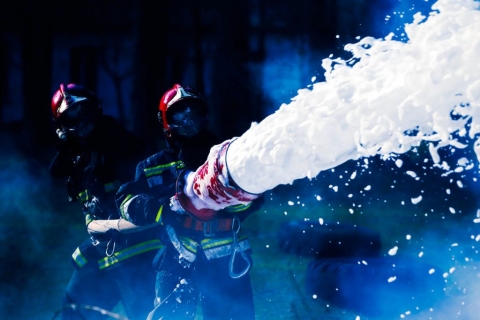
What are PFASs: Per- and polyfluoroalkylated substances
Per- and polyfluoroalkylated substances (PFAS) are a group of man-made chemicals that are used in a wide variety of applications due to their water, grease and dirt repellent properties.
Per- and polyfluoroalkyl substances (PFAS) are a group of more than 4700 identified and listed molecules. This group is divided into two categories:
- Non-polymers;
- Polymers.
How PFASs work in fire-fighting foams
Perfluoroalkylated substances are composed of a hydrophobic fluorinated part whose length can vary and a hydrophilic part whose function can also vary.
The C-F bond is very strong, which makes PFASs very resistant to degradation even under extreme laboratory conditions (e.g. at very high temperatures).
The two hydrophilic and hydrophobic properties give PFASs the role of surfactants and fluorine will play a major role in reducing the surface tension of water and thus allow the formation of an aqueous film in the presence of hydrocarbons. Depending on the concentration, this film is mechanically and thermally resistant to prevent the supply of oxygen to the burning hydrocarbon slick, creating a thermal barrier, preventing evaporation and thus inhibiting hydrocarbon combustion.
Distinction between PFOS and PFOA
Among these "precursors" are 2 sub-families that are widely used in fire-fighting foams:
- PFOA (perfluorooctanoic acid) ;
- PFOS (perfluorooctane sulphonic acid).
Their widespread use makes them the two main most dangerous and polluting substances in fluorinated surfactants. These PFOS and PFOA are called long-chain molecules because they contain 8 carbon atoms.
PFOS and PFOA are therefore substances classified by REACH as Persistent Organic Pollutants (POPs). These are organic substances that persist in the environment, accumulate in living organisms and constitute a risk to human health and the environment.
They can be transported by air, water or migratory species, reaching regions where they have never been produced or used. They are therefore very long-range pollutants!
PFASs bind to blood serum proteins and can remain in the human body for years. Currently PFASs, mainly PFOS and PFOA, are found in the blood of almost everyone in the world.
Scientists have linked the most infamous substance in the family to date, PFOA, to numerous health problems, including kidney and testicular cancer, high cholesterol, reduced fertility, low birth weight, thyroid problems and reduced immune response to vaccines in children.
Alternatives to PFOS and PFOA
Alternative fluorinated foams: the short-chain route ... or the long-chain route:
In order to remedy the problem of degradation into "terminal PFAs", manufacturers have started to develop substitutes for short-chain PFASs with 4 and 6 carbon atoms, or long-chain PFASs (9 to 20 carbon atoms) which should not degrade into long-chain PFAASs (8 atoms), and therefore no longer be included in the list of "precursors".
At present, these alternatives still generate substances during their degradation that are often classified by ECHA as substances of very high concern (SVHC).
Foams based on alkyl fluorides, e.g. alcoholic alkyl fluorides (AFFF) without C6, seem to be the most promising.
Fluorine-free foams:
Non-fluorinated foams, such as protein-based foams, fluorine-free surfactant-based foams, quaternary ammonium salt (QAS) foams are some examples of potential alternatives to PFOS and PFOA containing foams. These foams have a slightly lower fire extinguishing performance than fluorinated foams, but can be used in many applications.
These alternatives are already used in some cases and are being evaluated for their effectiveness in large hydrocarbon fire situations.
European Directives and PFAS
In Europe, PFOS were banned in 2008 under the REACH (Registration, Evaluation, Authorisation and Restriction of Chemicals) regulation. PFOAs were also added to the list of Substances of Very High Concern (SVHC) in 2013 and have been subject to strict restrictions under REACH.
In 2020, the European Union banned the manufacture, placing on the market and use of PFOAs, some of their derivatives and certain products containing them. However, some exemptions were made for certain applications, such as fire-fighting foams for airports. These exemptions are being phased out.
It is important to note that EU Member States may adopt stricter measures than those set out in the EU regulation, and some countries have already put in place stricter regulations to limit or ban the use of PFOS and PFOA. Belgium is currently complying with the EU phase-out scheme.
European Directives in force:
- REGULATION (EC) No 850/2004 OF THE EUROPEAN PARLIAMENT AND OF THE COUNCIL of 29 April 2004 on persistent organic pollutants and amending Directive 79/117/EEC;
- REGULATION (EU) 2019/1021 OF THE EUROPEAN PARLIAMENT AND OF THE COUNCIL of 20 June 2019 on persistent organic pollutants (recast) ;
- COMMISSION REGULATION (EU) 2020/784 of 8 April 2020 amending Annex I to Regulation (EU) 2019/1021 of the European Parliament and of the Council to include perfluorooctanoic acid (PFOA), its salts and PFOA-related compounds;
- COMMISSION REGULATION (EU) 2021/1297 of 4 August 2021 amending Annex XVII to Regulation (EC) No 1907/2006 of the European Parliament and of the Council as regards perfluorocarboxylic acids with a chain length of 9 to 14 carbon atoms (C9-C14 PFCAs), their salts and C9-C14 PFCA-related substances.
Conclusion:
The need for alternative solutions to PFAS for fire-fighting foams is now well established. There is no single prospect of an equally effective solution. In the future, it must be taken into account that each type of foam has advantages and disadvantages in terms of cost, efficiency and environmental safety, and that the choice of a foam will depend on the specific requirements of each situation.
ANPI asbl, the National Association for Fire Protection, is at your disposal to study each request and to carry out the most relevant tests in its laboratories located in the heart of Europe, depending on the risks to be protected.
Would you like to know more about the expansion of our laboratory dedicated to the analysis of extinguishing agents? Click here!






